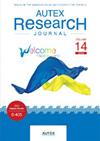考虑生产工艺和反射镜尺寸的反光纺织材料性能评定方法
IF 1.1
4区 工程技术
Q3 MATERIALS SCIENCE, TEXTILES
引用次数: 3
摘要
摘要:本研究从反光织物的可视性、热生理舒适性和耐用性(以物理机械性能为代表)的相互作用的角度考察了反光织物的效率。考察了两种生产技术(反射转移膜和丝网印刷方法)和两种反射膜覆盖尺寸(25%和85%)的组合效果。采用理想溶液相似性排序法(TOPSIS),综合考虑上述被测性质类别,确定最佳溶液。反射性能与被测图案的设计覆盖因子一致。结果发现,使用丝网印刷技术生产的测试图案的反射率明显低于用转移膜制作的相同图案的反射率。相反,在测试样品的热生理舒适性和物理力学性能方面,丝网印刷技术在几乎所有测试性能方面都表现出明显更好的结果,特别是在透气性、湿度管理和物理力学性能方面。上述矛盾结果的解决方案可以通过使用与这些技术方法中的每一种相关联的优点的组合来实现。丝网印刷可以应用于暴露在极端负荷或出汗的服装的特定区域,并且薄膜元素的转移确保了相对于标准和生物运动原理的高可见性,这些标准和生物运动原理被部署为行业的普遍基准。本文章由计算机程序翻译,如有差异,请以英文原文为准。
Approach to Performance Rating of Retroreflective Textile Material Considering Production Technology and Reflector Size
Abstract The study investigates retroreflective fabrics’ efficiency from the point of view of the interaction of their visibility, thermo-physiological comfort properties, and durability (represented by physical-mechanical performance). The effect of the combination of two production technologies (reflective transfer films and screen printing method) and two reflector covering sizes (25% and 85%) was examined. Technique for order of preference by similarity to ideal solution (TOPSIS) method was used to determine the best solution considering the abovementioned tested categories of properties. Retroreflective performance was in congruence with the used design coverage factor of the tested pattern. It was found that retroreflection of the tested pattern produced using screen printing technology was significantly lower than retroreflection of an identical pattern made by a transfer film. On the contrary, in terms of thermo-physiological comfort and physical-mechanical performance of the tested samples, screen printing technology shows significantly better results in almost all tested properties, especially in water vapor permeability, moisture management, and physical-mechanical performance. The solution for the abovementioned contradictory results can be achieved by using a combination of the advantages associated with each of these technology methods. Screen printing can be applied to specific regions of clothing that are exposed to extreme loading or sweating, and the transfer of film elements ensures high visibility with respect to the standards and biomotion principles that are deployed as prevalent benchmarks in the industry.
求助全文
通过发布文献求助,成功后即可免费获取论文全文。
去求助
来源期刊

Autex Research Journal
MATERIALS SCIENCE, TEXTILES-
CiteScore
2.80
自引率
9.10%
发文量
40
审稿时长
>12 weeks
期刊介绍:
Only few journals deal with textile research at an international and global level complying with the highest standards.
Autex Research Journal has the aim to play a leading role in distributing scientific and technological research results on textiles publishing original and innovative papers after peer reviewing, guaranteeing quality and excellence.
Everybody dedicated to textiles and textile related materials is invited to submit papers and to contribute to a positive and appealing image of this Journal.
 求助内容:
求助内容: 应助结果提醒方式:
应助结果提醒方式:


